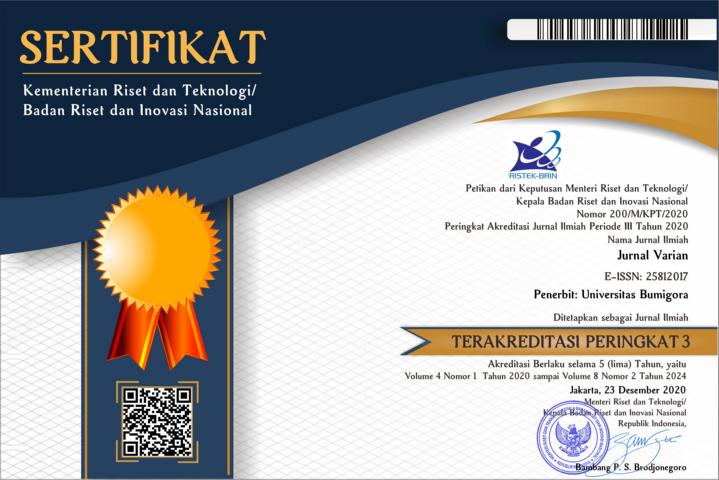Amount of Poverty as Policy Basis: A Forecasting Using The Holt Method
DOI:
https://doi.org/10.30812/varian.v4i1.849Keywords:
Forescasting, Exponential Smooting, Holt method, Poverty, Number of poor peopleAbstract
This research aims to predict the growth of the number of poor people in every district and city in NTB Province of Indonesia for the next 10 years by using Holt exponential smoothing method. This type of research is quantitative research with input data used over the last 19 years with a measure of the goodness of models namely MSE, MAD, and MAPE. Based on the optimization results obtained the smallest parameter at α of 0.9 and β of 0.1, an average value MSE of 278005053.7, MAD of 9992.28222, and MAPE of 8.9374 Optimization results also provide information that the increase in the growth of the average poor population of 70206.6604 Certainly this result can be used as a guideline by the government in determining steps and responding to rapid response strategies in dealing with this poverty problem.
References
Apriliyani, N., Rhomadhona, H., & Permadi, J. (2018). Aplikasi Peramalan Jumlah Siswa Sekolah Dasar di Kabupaten Tanah Laut Menggunakan Metode Holt’s Double Exponential Smoothing. Jurnal Sustainable: Jurnal Hasil Penelitian Dan Industri Terapan, 7(2), 64–69.
Awwaliyyah, N., & Mahmudah. (2014). Penerapan Metode Double Exponential Smoothing Dalam Meramalkan Jumlah Penderita Kusta Di Kabupaten Pasuruan Tahun 2014. Pontificia Universidad Catolica Del Peru, 8(33), 44.
Bidangan, J., Purnamasari, I., & Hayati, M. N. (2016). Perbandingan peramalan metode double exponential smoothing satu parameter brown dan metode double exponential smoothing dua parameter holt. 4(1).
Fachrudin, R. (2015). Evaluasi Kebijakan Penanggulangan Kemiskinan Pemerintah Kota Balikpapan. Jurnal Ilmu Sosial Dan Ilmu Politik Universitas Tribhuwana Tunggadewi, 4(2), 42-51.
Fety, F., M, H., Leni, M., Siti Fara, H., & Syaharuddin. (2020). Forcasting Peningkatan Jumlah Penduduk Berdasarkan Jenis Kelamin Menggunakan Metode ARIMA. Geography: Jurnal Kajian, Penelitian Dan Pengembangan Pendidikan, 8(1), 27–36.
Firnando, I. (2015). Implementasi Algoritma Apriori Dan Forecasting. Prosiding Sentia, 7(3), 2085–2347.
Lubis, I. A. (2019). Usulan Perencanaan Safety Stock & Forcasting Demand dengan Metode Time Series Produksi Keran Air di PT Kayu Perkasa Raya. Journal Industrial Engineering, 8(3), 1–9.
Mulyati, S., Fadilah, N., & Saleh, K. (2019). Peramalan Permintaan Toza Juice Strawberry Sebagai Dasar Penentuan Kebutuhan Persediaan Bahan Baku. Jurnal Agribisnis Terpadu, 12(2), 217.
Nasution, Z. (2019). Pertumbuhan Ekonomi dan Kemiskinan. ECOBISMA (Jurnal Ekonomi, Bisnis Dan Manajemen), 1(2), 1–10.
Negara, H. R. P., Syaharuddin, Kurniawati, K. R. A., & Negara, H. R. P. (2019). Analysis Of Nonlinear Models For The Acceleration Of Increasing HDI In Asia. IInternational Journal Of Scientific & Technology Research, 8(1), 60–62.
Putra, E. F., Asdi, Y., & Maiyastri, M. (2019). Peramalan dengan Metode Pemulusan Eksponensial Holt-Winter dan Sarima (Studi Kasus: Jumlah Produksi Ikan (Ton) di Kota Sibolga Tahun 2000-2017). Jurnal Matematika Unand, 8(1), 75.
Ramadhani, A. W., & Munandar, A. I. (2019). Determinan Kemiskinan Anak di Provinsi DKI Jakarta : SUSENAS 2017. Jurnal Ekonomi Kuantitatif Terapan, 12(2).
S, E. H., Jannah, M., Kurnia, L., & Satria, A. (2019). ARDL Method : Forecasting Data Kemiskinan di NTB. 3(1), 52–57.
Sucipto, L., & Syaharuddin, S. (2018). Konstruksi Forecasting System Multi-Model untuk pemodelan matematika pada peramalan Indeks Pembangunan Manusia Provinsi Nusa Tenggara Barat. Register: Jurnal Ilmiah Teknologi Sistem Informasi, 4(2), 114.
Syaharuddin;, Pramita, D., Nusantara, T., & Subanji. (2019). Accuracy Analysis of ANN Back Propagation, Neuro-Fuzzy, and Radial Basis Function: A Case of HDI Forecasting. International Journal of Engineering and Advanced Technology (IJEAT), 9(1), 1299–1304.
Downloads
Published
Issue
Section
How to Cite
Most read articles by the same author(s)
- Doni Dwiranata, Dewi Pramita, Syaharuddin Syaharuddin, Pengembangan Media Pembelajaran Matematika Interaktif Berbasis Android Pada Materi Dimensi Tiga Kelas X SMA , Jurnal Varian: Vol. 3 No. 1 (2019)
- Gilang Primajati, Ahmad Zuli Amrullah, Ahmad ahmad, Analisis Portofolio Investasi dengan Metode Multi Objektif , Jurnal Varian: Vol. 3 No. 1 (2019)
- Ahmad Ahmad, Nipaah Nipaah, PENGARUH EFEKTIVITAS DISTRAKTOR PADA ITEM TES PILIHAN GANDA TERHADAP PRESTASI BELAJAR MATEMATIKA SISWA , Jurnal Varian: Vol. 1 No. 1 (2017)
- Siti Soraya, Baiq Candra Herawati, Muttahid Shah, Syaharuddin Syaharuddin, Spatial Econometric Model on Economic Growth in West Nusa Tenggara , Jurnal Varian: Vol. 4 No. 2 (2021)
- Ahmad Ahmad, Ahmad Sehabuddin, EFEKTIVITAS PENGGUNAAN ALAT PERAGA TERHADAP PENINGKATAN PRESTASI BELAJAR SISWA PADA MATERI BANGUN RUANG SISI DATAR (KUBUS DAN BALOK) , Jurnal Varian: Vol. 1 No. 2 (2018)
- Gilang Primajati, Ahmad Ahmad, A Analisis Portofolio Investasi dengan Metode Mean Varian Dua Konstrain , Jurnal Varian: Vol. 2 No. 1 (2018)
- Astriyani Oktafian, Vera Mandailina, Mahsup Mahsup, Wasim Raza, Kirti Verma, Syaharuddin Syaharuddin, Regression Model of Land Area and Amount of Production to the Selling Price of Corn , Jurnal Varian: Vol. 6 No. 2 (2023)
- Habib Ratu Perwira Negara, Syaharuddin Syaharuddin, Ripai Ripai, SISTEM INFORMASI MANAJEMEN HUJAN DAN BANJIR RANCANGAN , Jurnal Varian: Vol. 1 No. 1 (2017)
- Kiki Riska Ayu Kurniawati, Sumeet Goyal, Biswadip Basu Mallik, Habib Ratu Perwira Negara, Syaharuddin Syaharuddin, Comparative Analysis of The Growth of School Students Using Autoregressive Integrated Moving Average Methods Analisis , Jurnal Varian: Vol. 5 No. 1 (2021)





















